- Rare earth: discovery and industry development
- The complex compositions of the two starting minerals cerite and gadolinite (ytterbite) are revealed in the flow chart of discoveries of rare earth elements (Figure 1). Whilst at the time cerite was the first of the rare earth minerals to be discovered, it was in ytterbite, (later renamed gadolinite) that new elements were first recognized, and the chemistry of the rare earths began in 1794 with Gadolin's observation.
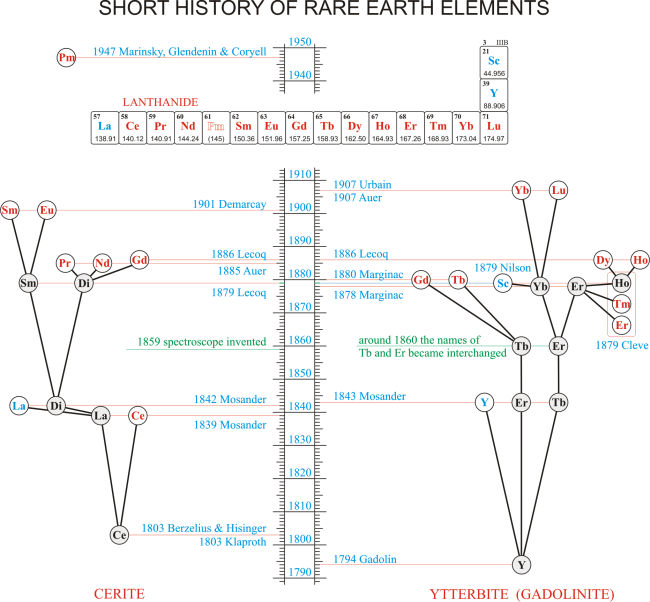
- Figure 1
- 150 years of rare earth history. The complex compositions of the two starting minerals, cerite and gadolinite (ytterbite), are revealed in the flow chart of discoveries of the elements.
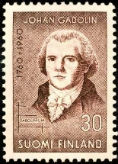 While examining a sample of rock from Swedish colleague Carl Axel Arrhenius, the Finnish chemist Johan Gadolin (1760-1852) was able to show that the new mineral contained 23% silicon dioxide, 4.5% beryllium oxide, 16.5% iron oxide, and about 55.5% of a new oxide he called ytterbia. Three years later, the Swedish chemist and mineralogist Anders Gustaf Ekeberg (1767-1813) had confirmed Gadolin's analysis and he shortened the name ytterbia to yttria.
While examining a sample of rock from Swedish colleague Carl Axel Arrhenius, the Finnish chemist Johan Gadolin (1760-1852) was able to show that the new mineral contained 23% silicon dioxide, 4.5% beryllium oxide, 16.5% iron oxide, and about 55.5% of a new oxide he called ytterbia. Three years later, the Swedish chemist and mineralogist Anders Gustaf Ekeberg (1767-1813) had confirmed Gadolin's analysis and he shortened the name ytterbia to yttria. - After the discovery of yttria, chemists looked closely at Cronstedt's 'heavy stone from Bastanäs'. In 1803, the Swedish ironmaster and scientist Wilhelm Hisinger (1766-1852), together with the young chemist Jöns Jakob Berzelius (1779-1848), analysed a sample of the 'tungsten (heavy stone) of Bastanäs', and isolated an earth similar to yttria but recognized it was distinct. The Swedish chemists named the new earth ceria, from the asteroid Ceres, discovered two years before in 1801-between Mars and Jupiter-by the Italian monk and astronomer Guiseppe Piazza (1746-1826).
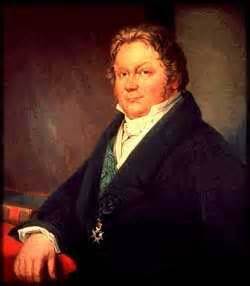 At the same time and independently of Hisinger and Berzelius, the German chemist Martin Klaproth (1743-1817) also analysed tungsten from Bastanäs and came to the same conclusion: it contained a new element which he called ochroite (from the Greek ochra meaning yellow brown) due to the light brown color of the pure substance. Hisinger, Berzelius and Klaproth are usually named as co-discoverers of cerium.
At the same time and independently of Hisinger and Berzelius, the German chemist Martin Klaproth (1743-1817) also analysed tungsten from Bastanäs and came to the same conclusion: it contained a new element which he called ochroite (from the Greek ochra meaning yellow brown) due to the light brown color of the pure substance. Hisinger, Berzelius and Klaproth are usually named as co-discoverers of cerium. 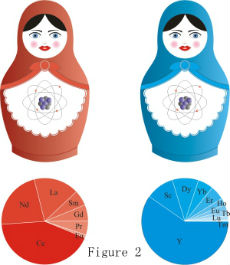 But no one was aware that the new elements are like Russian matryoshka dolls (Figure 2). Then, in 1839, Berzelius's student, the Swedish chemist Carl Gustav Mosander (1797-1858), separated ceria into pure ceria and an earth which he named lanthana (from the Greek word lanthanein, to lie hidden, because it lay hidden in the mineral cerite for 36 years after ceria was discovered in 1803). In 1842 he showed that lanthana contained another earth, which he called didymia (from the Greek didymos meaning twins because it closely resembled lanthana).
But no one was aware that the new elements are like Russian matryoshka dolls (Figure 2). Then, in 1839, Berzelius's student, the Swedish chemist Carl Gustav Mosander (1797-1858), separated ceria into pure ceria and an earth which he named lanthana (from the Greek word lanthanein, to lie hidden, because it lay hidden in the mineral cerite for 36 years after ceria was discovered in 1803). In 1842 he showed that lanthana contained another earth, which he called didymia (from the Greek didymos meaning twins because it closely resembled lanthana). - Rare earth elements as Russian nesting dolls (matryoshka or babushka dolls): red is 'ceria matryoshka' and blue is 'ittria matryoshka'.
- The following year, Mosander took 'yttria matryoshka' into his own hands. He separated yttria into three fractions: the first one, an oxide with a yellow color, he named erbia, the second one with a rosy color he named terbia, and the final fraction, a colorless oxide he continued to call yttria. Given that he separated the two new earths from yttria, Mosander derived the names of terbia and erbia from the name of the village Ytterby.
- However, in the confusion arising from the similarity in the properties of the rare-earth elements, the names of two, terbium and erbium, became interchanged (around 1860).
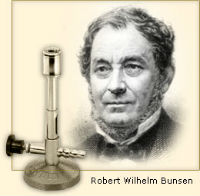 It was not until the invention of the spectroscope by the German chemist Robert Wilhelm Bunsen (1811-1899) and physicist Gustav Robert Kirchhoff (1824-1887) in 1859 and the development of spectral analysis that the tools for studying rare earths were finally provided.
It was not until the invention of the spectroscope by the German chemist Robert Wilhelm Bunsen (1811-1899) and physicist Gustav Robert Kirchhoff (1824-1887) in 1859 and the development of spectral analysis that the tools for studying rare earths were finally provided. - In 1878 the Swiss chemist Jean-Charles Galissard de Marignac (1817-1894) finally split one of the 'rare earth matryoshkas' triggering an avalanche of discoveries. He showed that Mosander's terbia, now erbia, could be separated into two earths: the rose-colored earth he continued to call erbia and the colorless one he named ytterbia.
- Note:
- This small village on the Swedish island of Resarö, in the Stockholm archipelago, is now celebrated in the names of no less than four elements: yttrium (Y), terbium (Tb), erbium (Er), and ytterbium (Yb).
- This erbia was, however, still not a pure oxide. In the following year the Swedish chemist Per Theodor Cleve (1840-1905) split erbia into a purified erbia and two new earths: the brownish precipitate he named holmia (the Latin name of his native city Stockholm) and the greenish one he named thulia (after Thule, the old name for Scandinavia).
- One of these new earths was also impure and, in 1886, the French chemist Paul-Émile Lecoq de Boisbaudran (1838-1912) separated a new oxide from holmia, which he named dysprosia (after the Greek verb dysprositos, undoubtedly).
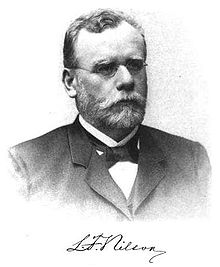 In 1879, during a routine procedure for isolating very pure ytterbia (ytterbium oxide, Yb2O3) from the rare-earth mineral euxenite the Swedish chemist Lars Fredrik Nilson (1840-1899) found traces of an unknown earth which he named scandia (this time after the Latin name for Scandinavia, Scandia).
In 1879, during a routine procedure for isolating very pure ytterbia (ytterbium oxide, Yb2O3) from the rare-earth mineral euxenite the Swedish chemist Lars Fredrik Nilson (1840-1899) found traces of an unknown earth which he named scandia (this time after the Latin name for Scandinavia, Scandia).- In 1880 Galissard de Marignac discovered that one fraction of gadolinite, known as terbia, contained a previously unknown element which he tentatively called Yα. Six years later, in 1886, de Boisbaudran separated a pure form of the earth Yα from Mosander's didymia. Boisbaudran proposed and Marignac agreed to rename Yα as gadolinium, after the mineral in which it was found.
- Finally in 1907, the French chemist Georges Urbain (1872-1938) and the Austrian chemist and engineer Carl Auer (1858-1929), who later became Baron von Welsbach, independently demonstrated that ytterbia contains one more oxide. Urbain's designation of the new element as lutetium, after the ancient name for his native city, Paris, was accepted by most, although Auer's name cassiopium, after the constellation Cassiopeia, was used in German-speaking countries for many years.
- On the other hand, 'ceria matryoshka' revealed even more hidden dolls within. In 1879, during analysis of the mineral samarskite, Boisbaudran found that ammonium hydroxide had caused a new precipitate to form before the formation of dydimia. He called the new earth samaria according to its mineral source.
- Note:
- The mineral samarskite was named after the Russian mining engineer, Colonel Vasilij Evgrafovič Samarskij-Byhovec (1803-1870) who supported the development of geology and mining in the Ural mountains. This rather unknown person was the first to have a chemical element named after him.
- In 1885 von Welsbach succeeded in separating the new didymia into two new earths which he named praesodymia (green didymia, its leek-green salts) and neodymia (new didymia), breaking the tradition of keeping the old name. So, after 40 years of being known as the element with the symbol Di, didymium was removed from the periodic table.
- Further spectroscopic analysis in 1886 of samaria by the French chemist Eugène-Anatole Demarçay (1852-1904) yielded new spectroscopic lines which were indicating an unknown element. Five years later, Demarçay had improved his separation technique and this enabled him to isolate some suitably pure samples of the new colorless earth, closely associated with samaria, which he named europium.
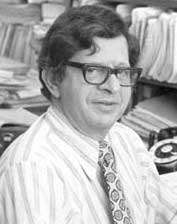 When the British physicist Henry Gwyn Jeffreys Moseley (1887-1915) developed the present-day scheme for assigning atomic numbers to the elements in 1912, it became apparent that one rare earth metal was missing between neodymium and samarium. Over the years several groups claimed to have produced element 61, but they could not confirm their discoveries because of the difficulty of separating it from other elements. The isolation and identification of element 61 was finally achieved in 1947 by the American chemists Jacob Akiba Marinsky (1918-2005), Lawrence Elgin Glendenin (1918-2008), and Charles DuBois Coryell (1912-1971) from the fission products of uranium fuel irradiated in a nuclear reactor at Oak Ridge, USA. The element promethium was appropriately named after Prometheus, son of Iapetus, who stole fire from Zeus's lightning and brought it to humans, because it was created in one of the first atomic fires lit by human hand.
When the British physicist Henry Gwyn Jeffreys Moseley (1887-1915) developed the present-day scheme for assigning atomic numbers to the elements in 1912, it became apparent that one rare earth metal was missing between neodymium and samarium. Over the years several groups claimed to have produced element 61, but they could not confirm their discoveries because of the difficulty of separating it from other elements. The isolation and identification of element 61 was finally achieved in 1947 by the American chemists Jacob Akiba Marinsky (1918-2005), Lawrence Elgin Glendenin (1918-2008), and Charles DuBois Coryell (1912-1971) from the fission products of uranium fuel irradiated in a nuclear reactor at Oak Ridge, USA. The element promethium was appropriately named after Prometheus, son of Iapetus, who stole fire from Zeus's lightning and brought it to humans, because it was created in one of the first atomic fires lit by human hand. - Source: http://www.periodni.com/rare_earth_elements.html

- As rare earth elements have certain indispensable and non-replaceable properties, the rare earth metals industry has rapidly developed widespread uses in the fields of electronics, magnetics, catalytics, national defense and new materials, as well as some other high-technology areas. With the growth of rare earth element consumption, products made from rare earth elements became more commonplace, and now include household appliances, iPods and computer hard drives, displays for other digital products, hybrid cars, catalytic converters, wind power generators and industrial motors. In addition, they are also essential to the growing fields of green energy technology and energy efficiency. However, as rare earth elements are of great importance to the development of society and all nations, and their consumption is increasing rapidly, so reserves are becoming fewer, and reasonable and sustainable development of rare earth elements has assumed particular prominence.
-
About us
Contact us
Make a suggestion
- Metalpedia is a non-profit website, aiming to broaden metal knowledge and provide extensive reference database to users. It provides users reliable information and knowledge to the greatest extent. If there is any copyright violation, please notify us through our contact details to delete such infringement content promptly.

 While examining a sample of rock from Swedish colleague Carl Axel Arrhenius, the Finnish chemist Johan Gadolin (1760-1852) was able to show that the new mineral contained 23% silicon dioxide, 4.5% beryllium oxide, 16.5% iron oxide, and about 55.5% of a new oxide he called ytterbia. Three years later, the Swedish chemist and mineralogist Anders Gustaf Ekeberg (1767-1813) had confirmed Gadolin's analysis and he shortened the name ytterbia to yttria.
While examining a sample of rock from Swedish colleague Carl Axel Arrhenius, the Finnish chemist Johan Gadolin (1760-1852) was able to show that the new mineral contained 23% silicon dioxide, 4.5% beryllium oxide, 16.5% iron oxide, and about 55.5% of a new oxide he called ytterbia. Three years later, the Swedish chemist and mineralogist Anders Gustaf Ekeberg (1767-1813) had confirmed Gadolin's analysis and he shortened the name ytterbia to yttria.  At the same time and independently of Hisinger and Berzelius, the German chemist Martin Klaproth (1743-1817) also analysed tungsten from Bastanäs and came to the same conclusion: it contained a new element which he called ochroite (from the Greek ochra meaning yellow brown) due to the light brown color of the pure substance. Hisinger, Berzelius and Klaproth are usually named as co-discoverers of cerium.
At the same time and independently of Hisinger and Berzelius, the German chemist Martin Klaproth (1743-1817) also analysed tungsten from Bastanäs and came to the same conclusion: it contained a new element which he called ochroite (from the Greek ochra meaning yellow brown) due to the light brown color of the pure substance. Hisinger, Berzelius and Klaproth are usually named as co-discoverers of cerium.  But no one was aware that the new elements are like Russian matryoshka dolls (Figure 2). Then, in 1839, Berzelius's student, the Swedish chemist Carl Gustav Mosander (1797-1858), separated ceria into pure ceria and an earth which he named lanthana (from the Greek word lanthanein, to lie hidden, because it lay hidden in the mineral cerite for 36 years after ceria was discovered in 1803). In 1842 he showed that lanthana contained another earth, which he called didymia (from the Greek didymos meaning twins because it closely resembled lanthana).
But no one was aware that the new elements are like Russian matryoshka dolls (Figure 2). Then, in 1839, Berzelius's student, the Swedish chemist Carl Gustav Mosander (1797-1858), separated ceria into pure ceria and an earth which he named lanthana (from the Greek word lanthanein, to lie hidden, because it lay hidden in the mineral cerite for 36 years after ceria was discovered in 1803). In 1842 he showed that lanthana contained another earth, which he called didymia (from the Greek didymos meaning twins because it closely resembled lanthana).  It was not until the invention of the spectroscope by the German chemist Robert Wilhelm Bunsen (1811-1899) and physicist Gustav Robert Kirchhoff (1824-1887) in 1859 and the development of spectral analysis that the tools for studying rare earths were finally provided.
It was not until the invention of the spectroscope by the German chemist Robert Wilhelm Bunsen (1811-1899) and physicist Gustav Robert Kirchhoff (1824-1887) in 1859 and the development of spectral analysis that the tools for studying rare earths were finally provided.  In 1879, during a routine procedure for isolating very pure ytterbia (ytterbium oxide, Yb2O3) from the rare-earth mineral euxenite the Swedish chemist Lars Fredrik Nilson (1840-1899) found traces of an unknown earth which he named scandia (this time after the Latin name for Scandinavia, Scandia).
In 1879, during a routine procedure for isolating very pure ytterbia (ytterbium oxide, Yb2O3) from the rare-earth mineral euxenite the Swedish chemist Lars Fredrik Nilson (1840-1899) found traces of an unknown earth which he named scandia (this time after the Latin name for Scandinavia, Scandia). When the British physicist Henry Gwyn Jeffreys Moseley (1887-1915) developed the present-day scheme for assigning atomic numbers to the elements in 1912, it became apparent that one rare earth metal was missing between neodymium and samarium. Over the years several groups claimed to have produced element 61, but they could not confirm their discoveries because of the difficulty of separating it from other elements. The isolation and identification of element 61 was finally achieved in 1947 by the American chemists Jacob Akiba Marinsky (1918-2005), Lawrence Elgin Glendenin (1918-2008), and Charles DuBois Coryell (1912-1971) from the fission products of uranium fuel irradiated in a nuclear reactor at Oak Ridge, USA. The element promethium was appropriately named after Prometheus, son of Iapetus, who stole fire from Zeus's lightning and brought it to humans, because it was created in one of the first atomic fires lit by human hand.
When the British physicist Henry Gwyn Jeffreys Moseley (1887-1915) developed the present-day scheme for assigning atomic numbers to the elements in 1912, it became apparent that one rare earth metal was missing between neodymium and samarium. Over the years several groups claimed to have produced element 61, but they could not confirm their discoveries because of the difficulty of separating it from other elements. The isolation and identification of element 61 was finally achieved in 1947 by the American chemists Jacob Akiba Marinsky (1918-2005), Lawrence Elgin Glendenin (1918-2008), and Charles DuBois Coryell (1912-1971) from the fission products of uranium fuel irradiated in a nuclear reactor at Oak Ridge, USA. The element promethium was appropriately named after Prometheus, son of Iapetus, who stole fire from Zeus's lightning and brought it to humans, because it was created in one of the first atomic fires lit by human hand. 
